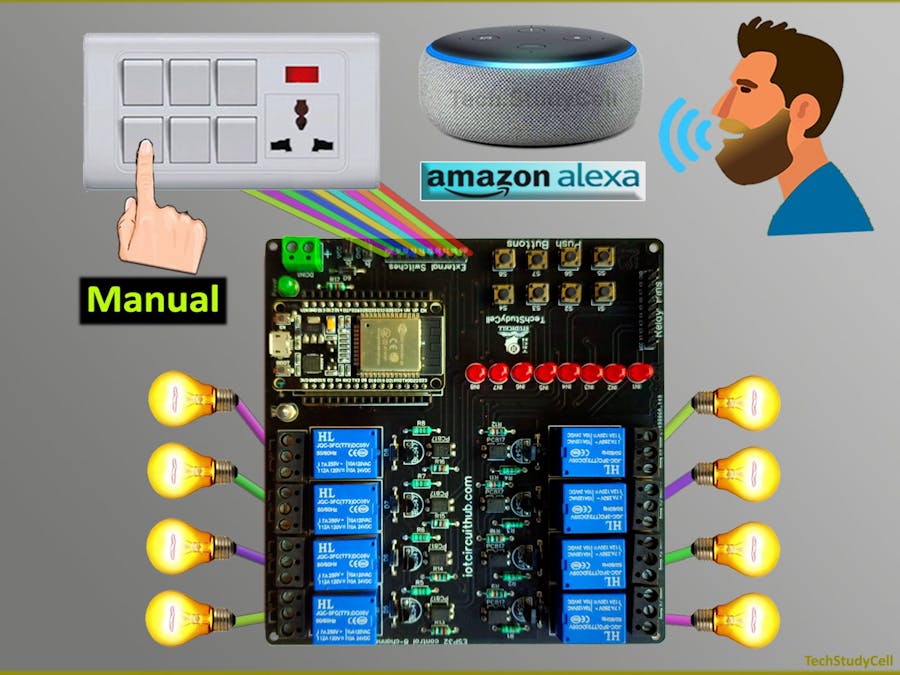IoT based Smart Home Automation Using Amazon Alexa & ESP32 to control 8 home appliances from the manual switch & Amazon Alexa App. If the internet is not available, then you can control the home appliances from manual switches. During the article, I have shown all the steps to make this smart home system.
This ESP32 control smart relay has the following features:
1. Control home appliances with voice commands using Alexa
2. Control home appliances with manual switches.
3. Monitor real-time feedback in the Alexa App.
4. Control home appliances manually without internet.
Required Components:1. ESP32 DEVKIT V1 board
2. 8-channel SPDT 5V Relay Module
3. Alexa Echo Dot (Optional)
4. Manual Switches
Required Components for the PCB1. Relays 5v (SPDT) (8 no)
2. BC547 Transistors (8 no)
3. PC817 Optocuplors (8 no)
4. 510-ohm 0.25-watt Resistor (8 no) (R1 - R8)
5. 1k 0.25-watt Resistors (10 no) (R9 - R18)
6. LED 5-mm (10 no)
7. 1N4007 Diodes (8 no) (D1 - D8)
8. Push Buttons (8 no)
9. Terminal Connectors
10. 5V DC supply
Required Software:1. Arduino IDE
2. Amazon Alexa App
Circuit Diagram of the ESP32 Project:This is the complete circuit diagram for this home automation project. I have explained the circuit in the tutorial video.
The circuit is very simple, I have used the GPIO pins D23, D22, D21, D19, D18, D5, D25 & D26 to control the 8 relays.
And the GPIO pins D13, D12, D14, D27, D33, D32, D15 & D4 connected with switches to control the 8 relays manually.
I have used the INPUT_PULLUP function in Arduino IDE instead of using the pull-up resistors.
I have used a 5V mobile charger to supply the smart relay module.
Control Relays With Voice Commands Using AlexaIf the ESP32 module is connected with the WiFi, then you can control the home appliances from Amazon Alexa App and also from the manual switches.
You can control, monitor the real-time status of the relays in the Alexa App from anywhere in the world.
You don't need an Alexa device for this home automation project.
Control Relays Using Switches:If the WiFi is not available, you can control the relays from the manual switches.
The ESP32 will check for the WiFi after every 3 seconds. When the WiFi is available, the ESP32 will automatically connect with the WiFi.
Please refer to the circuit diagram to connect the manual switches.
Create an Account in SinricFirst, visit https://sinric.com/login
Click on Register.
You have to create an account in Snric.
Then log in to Sinric Account.
You will get an API key which will be required in the code.
Now click on Add.
Add Devices in SinricThen enter a name for the device. Alexa will identify the device with that name.
Select the type as Switch.
Click on Save.
In this way add 8 devices in Sinric. Each device will get a unique device ID.
Program ESP32 Using Arduino IDEFirst, you have to install the required libraries. I have shared all the links in the code.
Then enter the API key & WiFi credentials
#define MyApiKey "----------------"
#define MySSID "--------"
#define MyWifiPassword "------"Then enter the device IDs for each device.
String device_ID_1 = "------------------------";
String device_ID_2 = "------------------------";
String device_ID_3 = "------------------------";
String device_ID_4 = "------------------------";
String device_ID_5 = "------------------------";
String device_ID_6 = "------------------------";
String device_ID_7 = "------------------------";
String device_ID_8 = "------------------------";After that select the DOIT ESP32 DEVKIT V1 board and the PORT. Then click on the upload button.
While uploading if you see the "Connecting.....___" text, press the BOOT button of ESP32.
Configure the Alexa App for This Smart Home SystemDownload and install the Amazon Alexa App from the Google play store or app store.
Go to "More", then select "Skills & Games"
Search for Sinric and tap on "Sinric".
Tap on "ENABLE TO USE"
Connecting Devices With AlexaLog in with the Sinric account credentials.
Goto Alexa and tap on "DISCOVER DEVICES".
It will take a minute to add devices. During this time the ESP32 should be connected with the WiFi.
Tap on "Devices", and tap on "Switch" to see all the devices.
Design the PCB for This Smart Home SystemTo make the circuit compact and give a professional look, I have designed the PCB after testing all the features of the smart relay module.
You can download the PCB Gerber file of this home automation project from the following link: https://drive.google.com/uc?export=download&id=1Y8rXnczq6baxAKOrBEE8aro-uqcK0J93
Order the PCBAfter downloading the Garber file you can easily order the PCB1. Visit https://jlcpcb.com and Sign in / Sign up
2. Click on the QUOTE NOW button.
3. Click on the "Add your Gerber file" button. Then browse and select the Gerber file you have downloaded.
Uploading the Gerber File and Set the Parameters4. Set the required parameter like Quantity, PCB masking color, etc.
5. After selecting all the Parameters for PCB click on SAVE TO CART button.
Select Shipping Address and Payment Mode6. Type the Shipping Address.
7. Select the Shipping Method suitable for you.
8. Submit the order and proceed for the payment.
You can also track your order from the JLCPCB.com.
My PCBs took 2 days to get manufactured and arrived within a week using the DHL delivery option.
PCBs were well packed and the quality was really good at this affordable price.
Solder All the Components on PCBAfter that, I have soldered all the components as per the circuit diagram.
Then connect the ESP32 board with PCB.
Testing the ESP32 Home Automation CircuitAfter uploading the code, if the ESP32 connects with the WiFi, the blue LED will turn on.
Then you can control the relay module from Amazon Alexa App.
Connect the Home AppliancesConnect the 8 home appliances as per the circuit diagram. Please take proper safety precautions while working with high voltage.
Connect 5-volt DC supply with the PCB. (I have used my old mobile charger)
Turn ON the SupplyTurn on the 110V/230V supply and 5V DC supply.
Finally!! the Alexa Home Automation System Is ReadyNow you can control your home appliances in a smart way.
I hope you have liked this Alexa home automation project. I have shared all the required information for this project. I will really appreciate it if you share your valuable feedback.
Also if you have any query please write in the comment section. Thank you & Happy Learning.




















Comments
Please log in or sign up to comment.